Containers are Linux, but they can still run on macOS with the help of a thin virtualization layer, inside a Linux virtual machine. But while the CPU and RAM are accessed at native speed, GPU acceleration has always been a challenge.
Earlier this year, we demonstrated how the enablement of Venus-Vulkan boosted GPU computing performance by 40x, reaching up to 75–80% of the native performance. In this post, we introduce a preview of our latest work, which closes the gap and brings llama.cpp AI inference to native speed in most use cases.
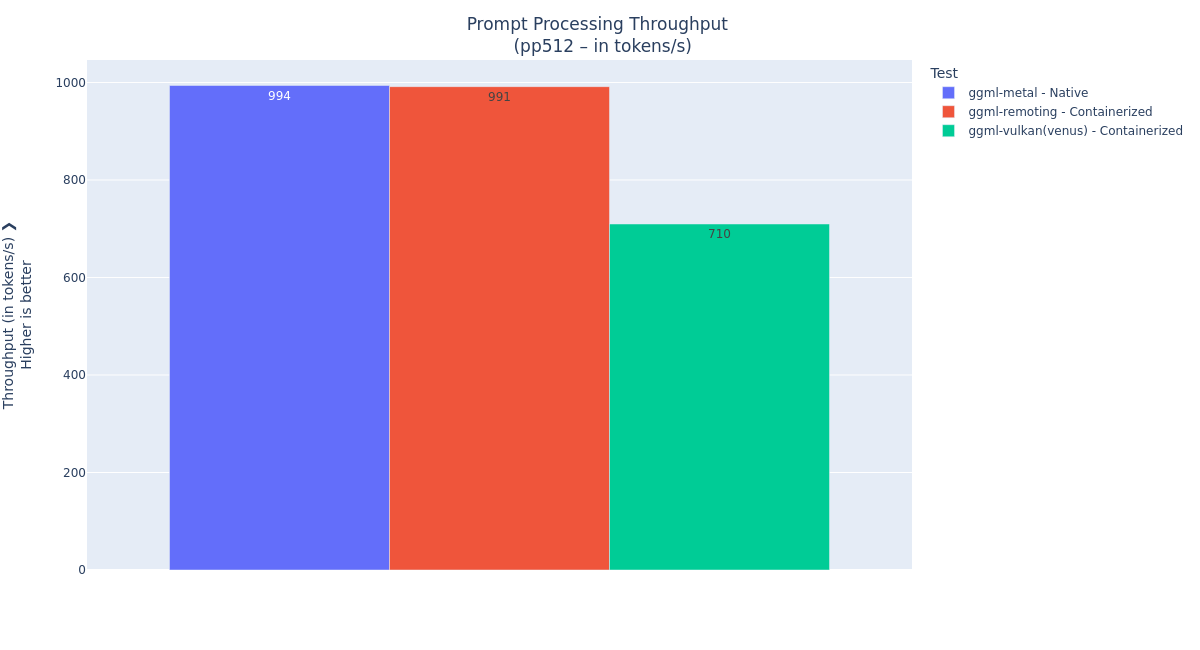
The llama.cpp API remoting architecture
The challenge of running AI inference inside containers on macOS is that OCI containers do not run natively on macOS—they need the Linux kernel. So, Podman launches a Linux virtual machine, powered by the open source libkrun/krunkit projects.
Our API remoting accelerator runs on top of libkrun‘s VirtIO virt-gpu support and leverages the same technique as Mesa Venus-Vulkan: forwarding API calls between the virtual machine and the host system. The Mesa project provides a general-purpose solution, where the calls to the Vulkan API are serialized with the Venus protocol, and forwards them to the host via the Virtio virt-gpu. On the host, the virglrenderer library deserializes the call parameters and invokes the MoltenVK Vulkan library, which is built on top of Apple Metal API.
On our acceleration module, we chose to focus on a narrower target: AI inference with llama.cpp GGML tensor library. The acceleration stack consists of four components:
- ggml-remotingfrontend, a custom GGML library implementation running in the container of the Linux virtual machine.
libkrun's virtio-gpu and its Linux driver (unmodified).- virglrenderer, a modified version of the upstream library that supports loading a secondary library and forwarding calls to it.
- ggml-remotingbackend, a custom GGML library client running on the host. It receives call requests from the
virglrendererand invokes theggml-metallibrary to drive thellama.cppGPU acceleration.
Figure 2 shows an overview of the architecture.
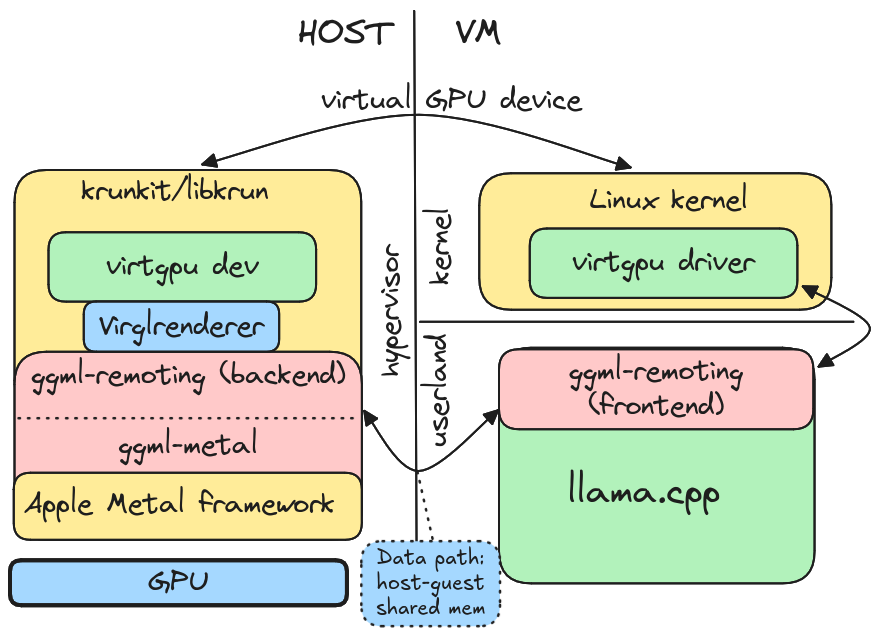
llama.cpp API remoting architecture.Considerations for API remoting
A frequent question about API remoting is whether it breaks VM/container isolation.
By nature, it creates a communication link between the VM container and the host system to access the GPU, so it does indeed breach part of the VM isolation. However, it's a matter of trade-offs between performance and strong isolation.
Key advantages in this proof-of-concept implementation:
- The VM hypervisor runs with simple user privileges. This is by design of the Podman machine/
libkrunstack and not specific to this work. - The back end and the GPU only execute trusted code. It is the
ggml-metalback-end library, loaded by the hypervisor on the host, contains all the necessary GPU kernel code. This eliminates a whole class of risks coming from the execution of malicious kernels.
Current limitations and considerations:
- The back-end library lives within the hypervisor address space. A crash within the back-end library could bring down the hypervisor. This extends the risk of a vulnerability in the trusted code that can be exploited by a malicious model. The mature and sound
llama.cppcode base, along with vulnerability management techniques and patching, would reduce this. - The back-ends of multiple containers run in the same address space. (Note: While the current implementation only allows one container to run at a time, this limitation is slated to be lifted in future releases.) But from the GPU point of view, the different containers are not isolated:
- In terms of execution, invalid operations from one container can crash another container.
- In terms of security, one container might be able to access the GPU data of another container. This threat is mitigated by the fact that the containers do not provide the GPU kernel code; they can only trigger existing
ggml-metalkernels. However, the threat is not fully eliminated; vulnerabilities could still exploit it.
Overall, we can say that this API remoting design isn't multitenant safe.
API remoting benchmarks
We validated the stability and performance of our acceleration stack by running the llama.cpp's llama-bench benchmark over various model families, sizes, and quantizations on different Mac systems. We looked at the performance of prompt processing pp512, which measures how fast the AI engine processes the input text (relevant when feeding large documents), and token generation (tg128), which measures how fast the AI generates text (important for the user experience).
Testing with various Mac hardware
Figures 3 and 4 show the prompt processing and token generation performance benchmarks with different Mac systems.
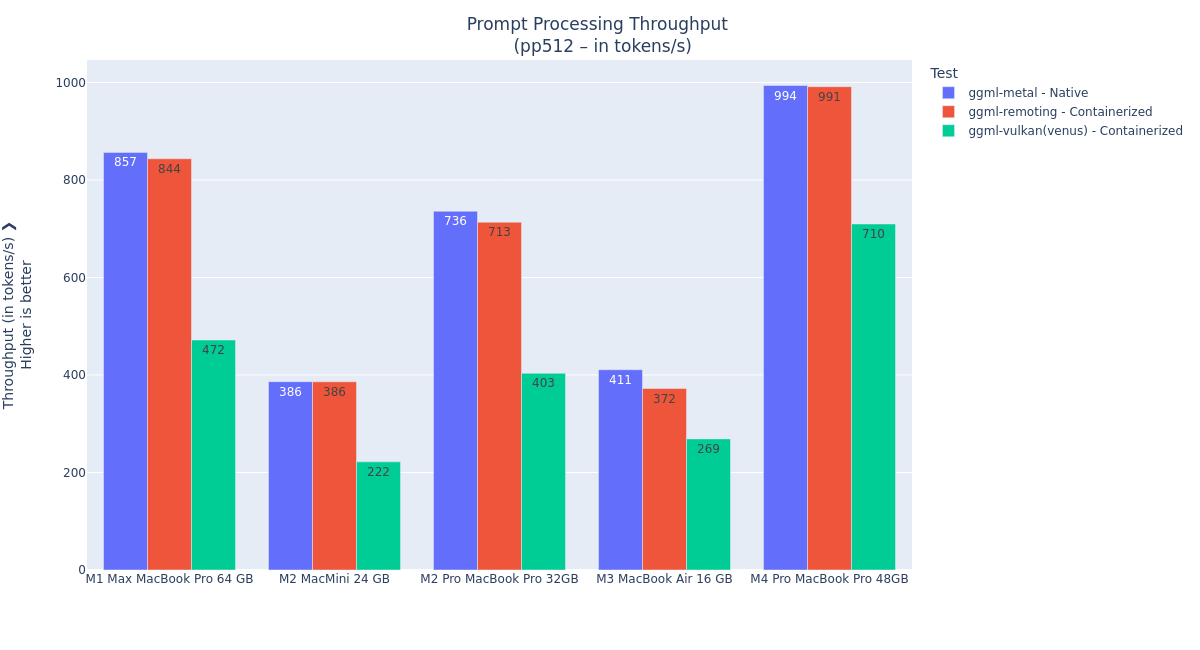
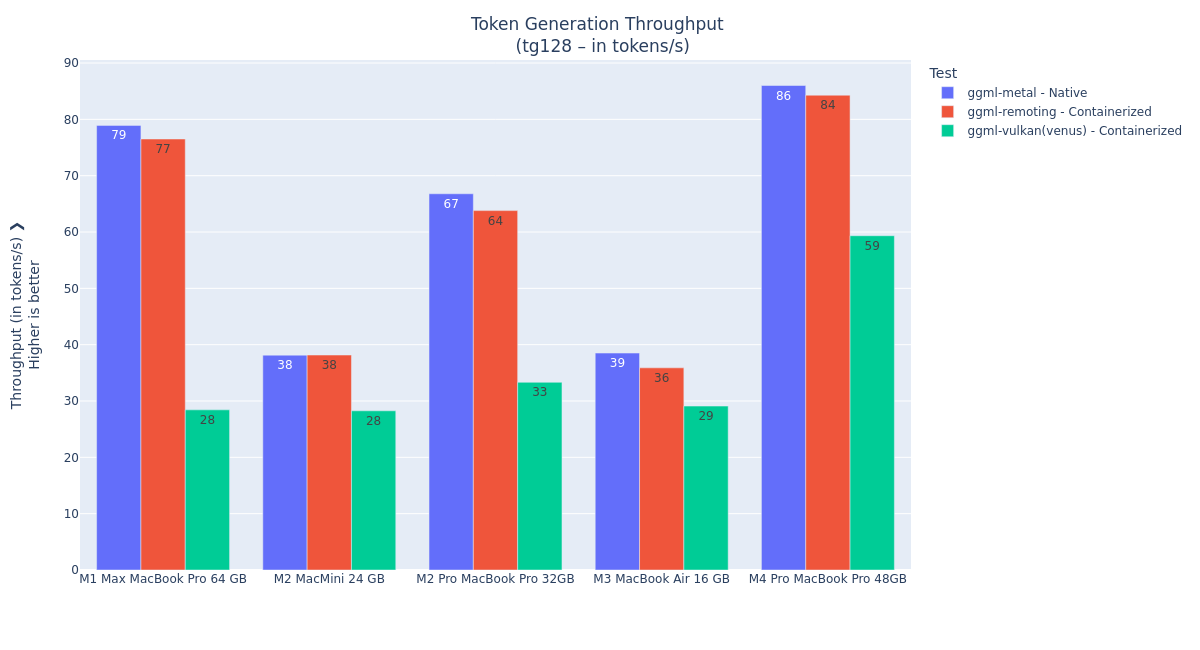
We can see that overall, the llama.cpp API remoting performance is mostly on par with native Metal performance. In the following tests, we only used the M4 Pro MacBook Pro 48 GB system.
The lower performance of the M2 Mac Mini and M3 MacBook Air systems most likely comes from the bottleneck of their RAM bandwidth, which is limited to 100 GB/s, while the other systems have more than double.
Testing with various model families
Figures 5 and 6 show the prompt processing and token generation performance benchmarks with different model families: granite3.3, llama3.2, mistral, phi, qwen (all from the Ollama repository, with the latest tag) on the M4 Pro MacBook Pro 48 GB system.
We see that with the llama.cpp API remoting acceleration, prompt processing and token generation are done at the native speed.
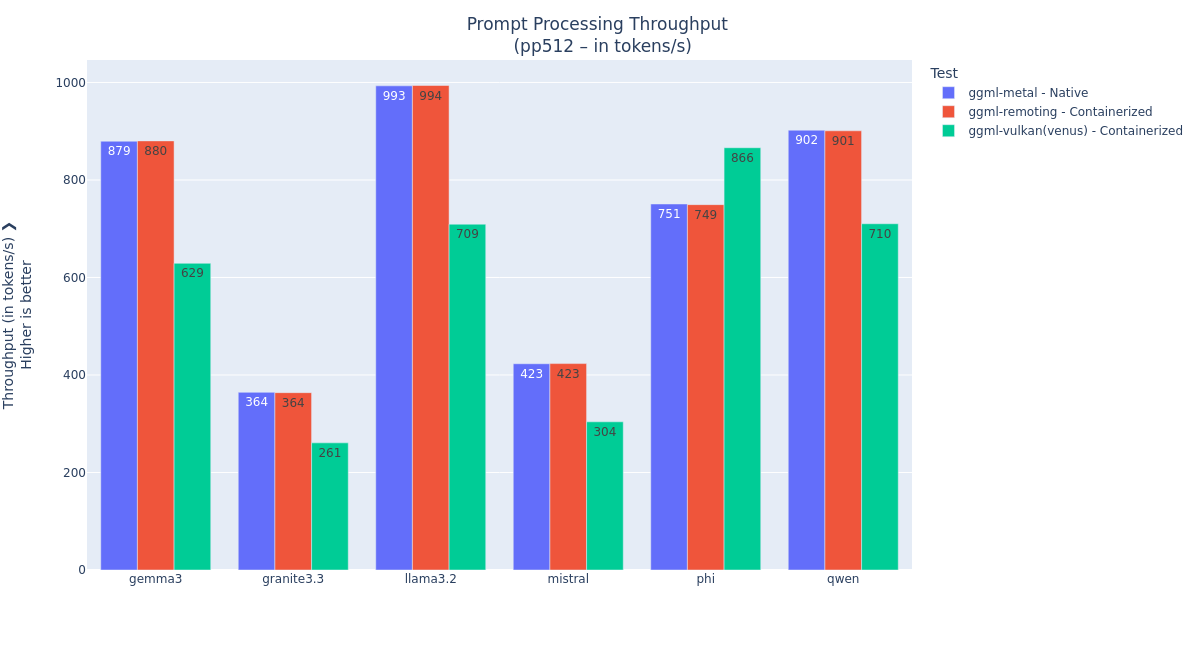
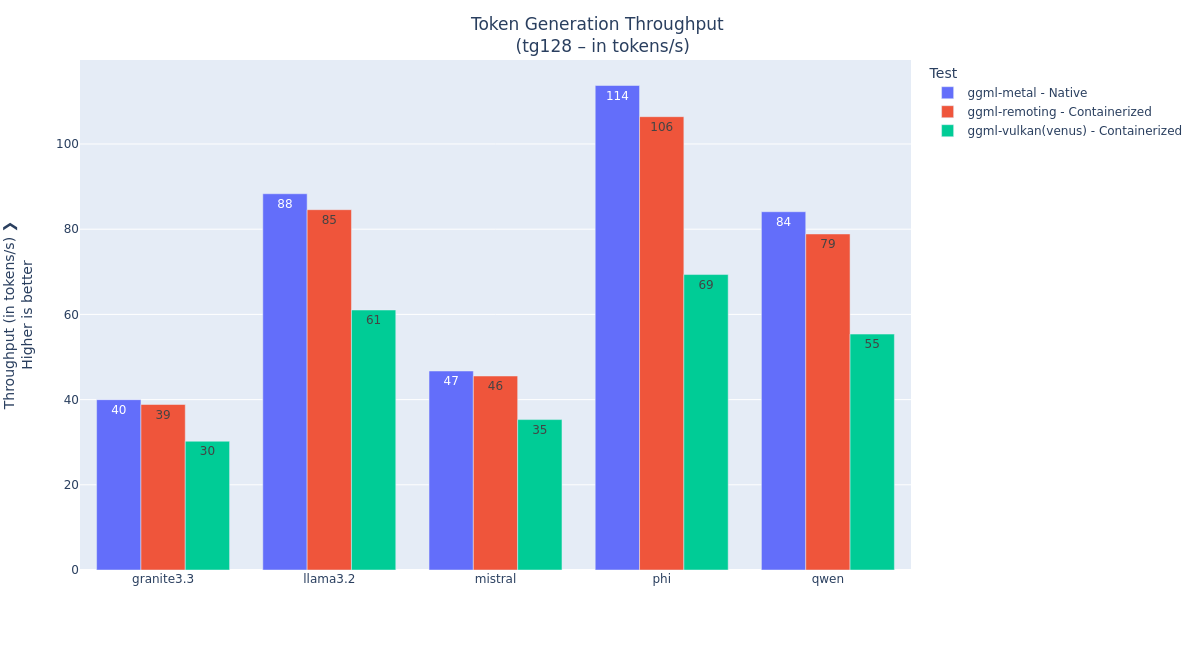
Testing with various model sizes
Figures 7 and 8 show the prompt processing and token generation performance benchmarks with different sizes of the llama2, llama3.1, and llama3.2 models on the M4 Pro MacBook Pro 48 GB system.
We see that with the llama.cpp API remoting acceleration, prompt processing was done at native speed, and the token generation is near native. The highest difference (95% of native) is observed with the smallest model, where the processing time gets low and the API remoting overhead becomes visible:
151.59 t/s⇔ 1 token every6.6ms145.29 t/s⇔ 1 token every6.7ms
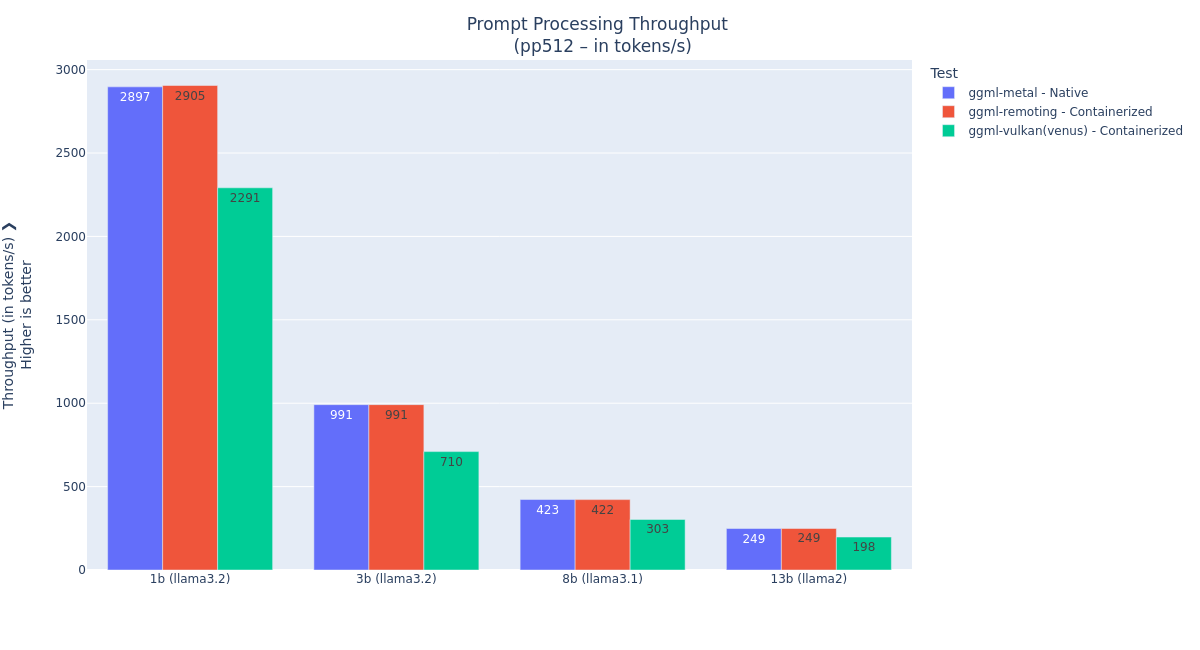
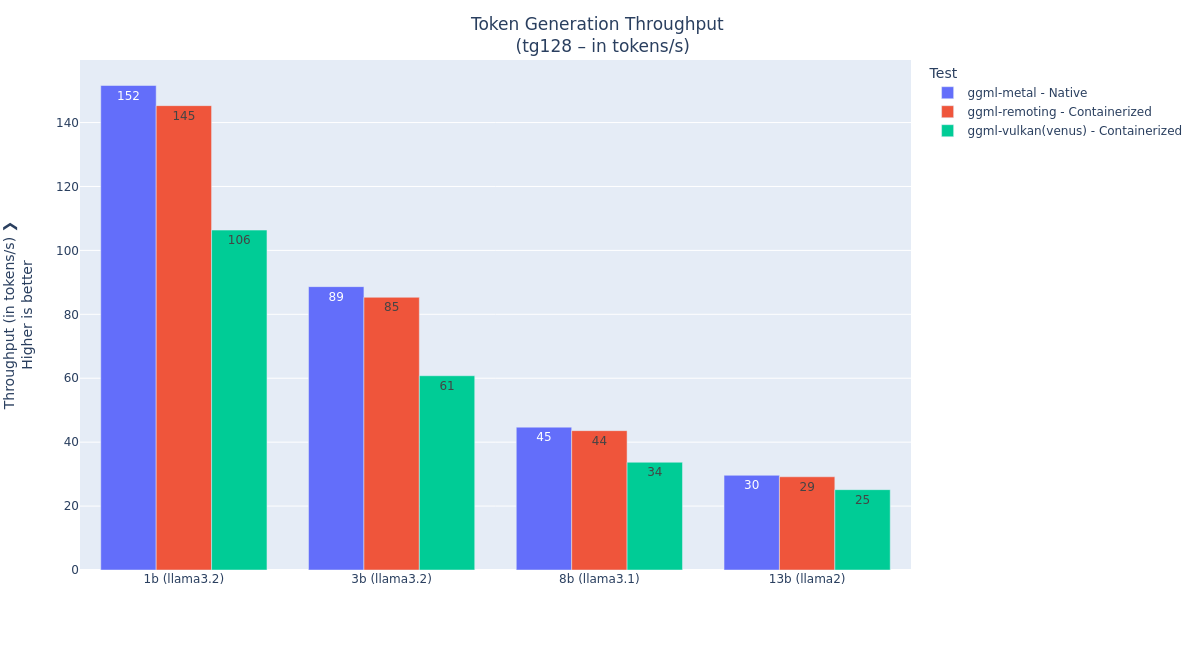
In the next section, I'll walk you through the steps to get the llama.cpp API remoting running on your system and how to run the back end to validate the performance.
Try with Podman Desktop
Install this extension in Podman Desktop:
quay.io/crcont/podman-desktop-remoting-ext:v0.1.3_b6298-remoting-0.1.6_b5Then select the following menus in the llama.cpp API remoting status bar:
- Restart Podman Machine with API remoting support: This restarts the Podman machine with the API remoting binaries.
- Launch an API Remoting accelerated Inference Server:
- Select the model.
- Enter a host port.
- Wait for the inference server to start. The first launch takes a bit of time, as it pulls the RamaLama remoting image, and
llama.cppneeds to precompile and cache its GPU kernels.
Play with the model that you launched, for example, with RamaLama:
ramalama chat --url http://127.0.0.1:1234
See the Benchmarking section for comparing the performance of API remoting against Venus-Vulkan and native Metal on your system.
Try API remoting with RamaLama
Download the API remoting libraries:
curl -L -Ssf https://github.com/crc-org/llama.cpp/releases/download/b6298-remoting-0.1.6_b5/llama_cpp-api_remoting-b6298-remoting-0.1.6_b5.tar | tar xv- Ensure that you have the Podman machine and
krunkitavailable (see the Prerequisites part of the tarball INSTALL.md), and RamaLama 0.12. Prepare the
krunkitbinaries to run with the API remoting acceleration.bash ./update_krunkit.shRestart the Podman machine with the API remoting acceleration. You can pass an optional machine name to the script if you don't want to restart the default machine.
bash ./podman_start_machine.api_remoting.sh [MACHINE_NAME]Now you can use RamaLama with the remoting image:
export CONTAINERS_MACHINE_PROVIDER=libkrun # ensures that the right machine provider is used ramalama run --image quay.io/crcont/remoting:v0.12.1-apir.rc1_apir.b6298-remoting-0.1.6_b5 llama3.2
Again, see the Benchmarking section below for comparing the performance of API remoting against Venus-Vulkan and native Metal on your system.
Run the benchmark with RamaLama
To benchmark the API remoting performance, the easiest way is to use the RamaLama llama.cpp benchmark.
- First, on Podman Desktop, stop any other API remoting inference server by selecting Stop the API Remoting Inference Server. Two API remoting containers cannot run simultaneously in this preview version.
Select Show RamaLama benchmark commands. This will show the following commands for RamaLama 0.12:
# API Remoting performance ramalama bench --image quay.io/crcont/remoting:v0.12.1-apir.rc1_apir.b6298-remoting-0.1.6_b5 llama3.2To compare it against the current container performance, launch the benchmark with the default image:
# Venus/Vulkan performance ramalama bench llama3.2And to compare it with native performance, launch RamaLama without a container:
brew install llama.cpp # native Metal performance ramalama --nocontainer bench llama3.2
If you want to share your experience or performance on crc-org/llama.cpp, also include:
- The version of the tarball (
llama_cpp-api_remoting-b6298-remoting-0.1.6_b5) - The name of the container image (
quay.io/crcont/remoting:v0.12.1-apir.rc1_apir.b6298-remoting-0.1.6_b5) - Or the version of the Podman Desktop extension (
v0.1.3_b6298-remoting-0.1.6_b5). The output of this command:
system_profiler SPSoftwareDataType SPHardwareDataType
Conclusion
This project was started to evaluate the suitability of API remoting to improve the performance of containerized AI inside MacOS virtual machines. The initial investigations confirmed that the core components were available in the stack: host-guest memory sharing and the ability for the guest to trigger code execution on the host. The VirtIO Virt-GPU implementation, which spans between the Linux guest kernel and the hypervisor, already provides these capabilities.
So, the proof-of-concept development effort first focused on extracting and adapting the relevant code from Mesa Venus and Virglrenderer to make it reusable in more lightweight projects. The second focus was on forwarding the GGML API calls between the guest and the host. The last focus was to optimize the interactions to improve the performance.
Next steps
The next steps for this work are to submit the changes upstream to the llama.cpp and virglrenderer projects. Once the patches are accepted, libkrun/krunkit and RamaLama/Podman Desktop will be extended to ship the API remoting libraries and enable them on demand.
Another step will be to review the use of the llama.cpp API remoting for RamaLama micro-VM, where libkrun is used in Linux systems to improve the isolation level of AI containers.
Finally, we are considering turning this API remoting project into a framework that could be used to enable new workloads to run with GPU acceleration inside virtual machines, such as PyTorch/MPS containers running on Apple macOS.
